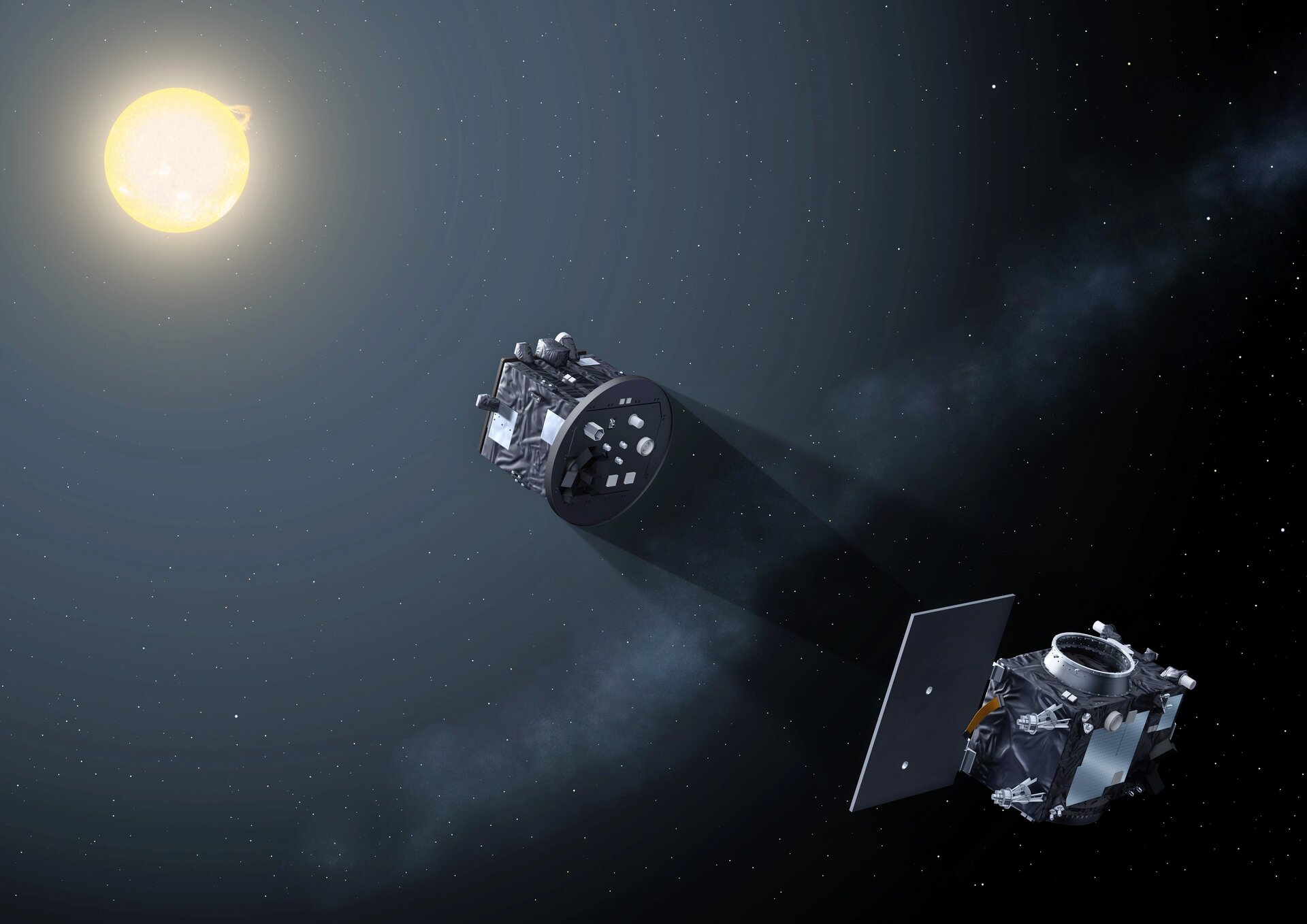


Following the recent Total Solar Eclipse, ISRO and ESA are partnering to launch Proba-3 spacecraft, which will use precision formation flying to artificially create solar eclipses in space. This innovative mission will allow for closer study of the Sun's mysterious corona and provide valuable insights into space weather. With cutting-edge technologies and precise coordination, Proba-3 is set to launch via the PSLV from India's Satish Dhawan Space Centre. Once in orbit, the spacecraft will autonomously perform formation flying, enabling six hours of observation per orbit and bridging the observational gap between the low and high corona.
Proba-3 Mission: Unveiling the Secrets of the Sun with Artificial Solar Eclipses
Following the spectacular Total Solar Eclipse in October 2023, the Indian Space Research Organization (ISRO) and the European Space Agency (ESA) are embarking on a groundbreaking mission to launch the Proba-3 spacecraft. This innovative mission will harness precision formation flying technology to create artificial solar eclipses in space, offering scientists unprecedented opportunities to study the Sun's enigmatic corona.
Background: The Importance of Studying the Corona
The corona is the outermost layer of the Sun's atmosphere, extending millions of kilometers into space. It plays a crucial role in space weather phenomena that can impact Earth's communications, power grids, and even astronauts in space. However, the corona is notoriously difficult to observe due to the Sun's intense brightness.
Proba-3 Mission: Artificial Solar Eclipses
The Proba-3 spacecraft will be launched into an elliptical orbit around Earth. Once in orbit, it will autonomously perform a complex formation flying maneuver with two separate instruments: Coronagraph 1 and Coronagraph 2.
By positioning Coronagraph 1 slightly ahead of the Sun and Coronagraph 2 precisely behind, Proba-3 will create artificial solar eclipses. During these eclipses, Coronagraph 1 will block the Sun's direct light, allowing Coronagraph 2 to capture detailed images of the corona.
Scientific Objectives
The Proba-3 mission aims to address several fundamental questions about the Sun's corona, including:
By studying the corona in unprecedented detail, Proba-3 will provide valuable insights into these phenomena and improve our understanding of space weather.
Launch and Timeline
The Proba-3 spacecraft is scheduled to launch in 2024 via the PSLV rocket from India's Satish Dhawan Space Centre. Once in orbit, it will begin its formation flying operations, enabling up to six hours of coronal observations per orbit. The mission is expected to have a lifespan of at least two years.
Top 5 FAQs
What is the purpose of creating artificial solar eclipses?
How long does each artificial eclipse last?
What instruments are used on Proba-3?
When is the Proba-3 mission expected to launch?
What is the scientific significance of the Proba-3 mission?

As meditation gains popularity as a mental well-being tool, concerns about potential side effects have emerged. A recent study by a team of researchers from the University of Melbourne delved into the prevalence of adverse experiences among meditators in the United States. By recruiting nearly 900 adults from various meditation skill levels, the study aimed to provide more accurate estimates of how common these side effects are and what factors may contribute to experiencing them. The findings highlight the need for clearer reporting standards in future research on meditation.

Prime Minister Narendra Modi launched a groundbreaking research, development and innovation scheme that will provide a boost to the flourishing ecosystem of innovation in India. In his address at the Emerging Science, Technology and Innovation Conclave, PM Modi highlighted the crucial role of science and technology in driving transformation and emphasized on India's significant progress in the field. He also acknowledged the remarkable achievement of India's women's cricket team and expressed confidence that their success would inspire the country's youth. Attendees included renowned scientists, innovators, and distinguished guests from both India and abroad.

Indian Prime Minister Narendra Modi inaugurated the Emerging Science and Technology Innovation Conclave (ESTIC) 2025 and launched the Rs 1 lakh crore Research Development and Innovation (RDI) Scheme Fund. The scheme aims to strengthen the private sector-driven research and innovation ecosystem in the country and has a total outlay of Rs 1 lakh crore over 6 years. ESTIC 2025, gathering over 3,000 participants, focuses on 11 critical thematic areas including Artificial Intelligence, Quantum Science and Technology, and Space Technologies, providing opportunities for collaboration and reinforcing India’s science and technology ecosystem.

In this edition of Health360, a renewed debate over the alleged link between vaccines and autism is sparked by tech mogul Sridhar Vembu's endorsement of a questionable study. Despite reassurances from the medical community backed by data from the WHO, doubts continue to persist, leading to potential harm to public health. The program also delves into the alarming rise in back pain cases in India and explores new treatments.

In an effort to fight the ongoing air pollution crisis, Delhi conducted its first-ever official cloud seeding operation led by IIT Kanpur. The operation involved a small aircraft dispersing specially designed chemical flares into the atmosphere to create rain. While experts say rainfall could occur within 15 minutes to 4 hours, the actual timeframe depends on various factors such as wind direction and moisture content. If successful, the government plans to continue the operation in the coming days.

In the quest for stronger, luscious hair, we often overlook the importance of nurturing the roots. Fortunately, Ayurveda has long stressed the significance of this practice, which has now been backed by modern science. Studies have shown that herbs like Bhringraj and Amla can activate hair follicles, promoting new growth and delaying greying. Fenugreek, Neem, Hibiscus, and Ashwagandha are also found to be beneficial in strengthening and nourishing the scalp, resulting in thicker and healthier hair.

A college student shares her personal journey of becoming a vegetarian, despite facing challenges and health concerns. She then delves into an ethics class she took, where the concept of marginal cases were discussed. Following an article by philosophy professor Alastair Norcross, she concludes that even though individual action may seem insignificant, refusing to consume factory-farmed meat holds moral significance due to the potential to prevent immense suffering for animals.

On October 24, the global community commemorates World Polio Day to honor the legacy of Dr. Jonas Salk and the efforts of countless individuals and organizations in the fight against polio. This highly contagious and potentially deadly disease, once a widespread epidemic, is now largely preventable thanks to the development of a life-saving vaccine. India's successful eradication of polio serves as a testament to the importance of strong vaccination programs and collaborations in public health initiatives.

As winter arrives in India, so does the hazardous air pollution. Delhi NCR's AQI has already crossed the 400 mark, making it crucial to invest in air purifiers, especially after Diwali. Dyson, Qubo, HomePure, and Philips have launched high-quality air purifiers with advanced features to tackle different types of pollutants and create cleaner indoor air. With prices ranging from Rs 5,000 to Rs 1 lakh, these purifiers are a practical and timely purchase for a healthier living.

In a recent family vlog, Indian celebrity couple Shoaib Ibrahim and Dipika Kakar shared their "natural" hair care routine for their son, using a homemade mask made with rice flour, flax seeds, and coconut oil. However, experts warn that what works for adults may not be suitable for babies, whose sensitive skin and scalp could react to the ingredients. While the ingredients may improve hair texture, they do not necessarily promote hair growth. Instead, a healthy diet and good scalp care are more important in maintaining healthy hair.